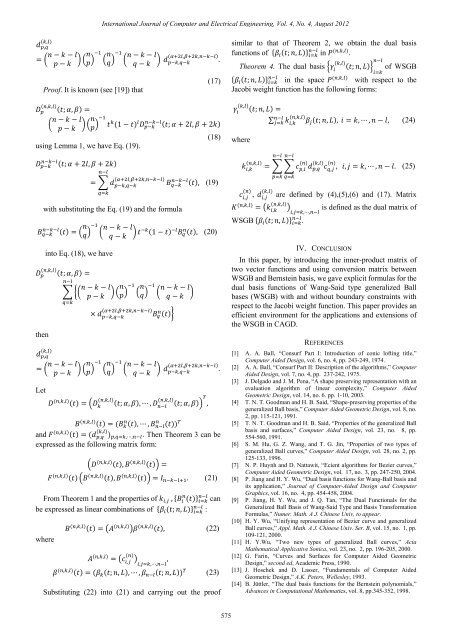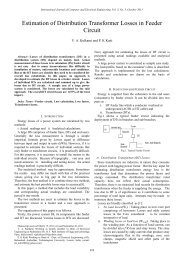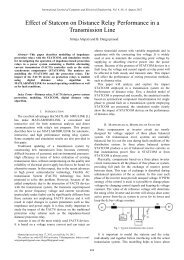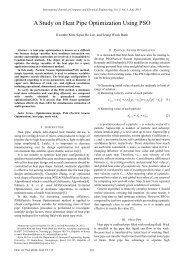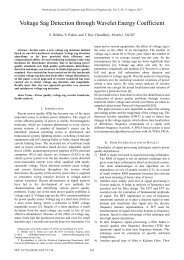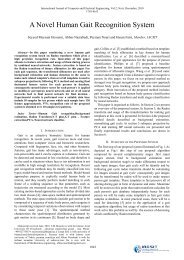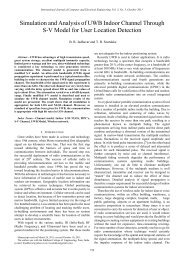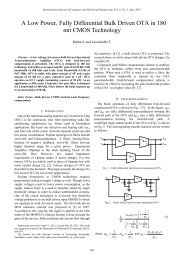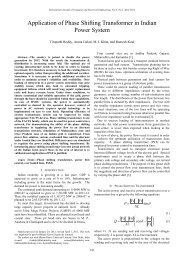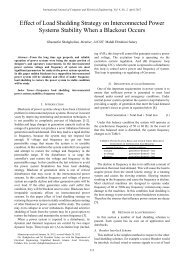The Weighted Dual Functions for Wang-Said Type ... - ijcee
The Weighted Dual Functions for Wang-Said Type ... - ijcee
The Weighted Dual Functions for Wang-Said Type ... - ijcee
Create successful ePaper yourself
Turn your PDF publications into a flip-book with our unique Google optimized e-Paper software.
International Journal of Computer and Electrical Engineering, Vol. 4, No. 4, August 2012<br />
,<br />
,<br />
<br />
<br />
<br />
<br />
,<br />
Proof. It is known (see [19]) that<br />
,, ; , <br />
,, .<br />
(17)<br />
<br />
<br />
1 ; 2, 2<br />
(18)<br />
using Lemma 1, we have Eq. (19).<br />
; 2, 2<br />
<br />
<br />
,,<br />
,<br />
<br />
<br />
with substituting the Eq. (19) and the <strong>for</strong>mula<br />
, ( 19 )<br />
<br />
1 , ( 20)<br />
into Eq. (18), we have<br />
,, ; , <br />
then<br />
,<br />
,<br />
<br />
<br />
<br />
<br />
<br />
<br />
<br />
<br />
<br />
,, ,<br />
<br />
<br />
<br />
,<br />
,, .<br />
Let<br />
,, ,, <br />
; , ,, ,, <br />
; , ,<br />
,, ,, <br />
<br />
and ,, , , ,,, . <strong>The</strong>n <strong>The</strong>orem 3 can be<br />
expressed as the following matrix <strong>for</strong>m:<br />
,, , ,, <br />
,, ,, , ,, . ( 21)<br />
From <strong>The</strong>orem 1 and the properties of , , <br />
can<br />
<br />
be expressed as linear combinations of ; , :<br />
where<br />
,, ,, ,, , ( 22)<br />
,, ,<br />
,<br />
,,,<br />
,, ; , ,, ; , ( 23)<br />
Substituting (22) into (21) and carrying out the proof<br />
similar to that of <strong>The</strong>orem 2, we obtain the dual basis<br />
<br />
functions of ; , in ,, .<br />
<strong>The</strong>orem 4. <strong>The</strong> dual basis , <br />
<br />
; , of WSGB<br />
<br />
<br />
; , in the space ,, with respect to the<br />
Jacobi weight function has the following <strong>for</strong>ms:<br />
, <br />
; , <br />
<br />
∑ ,, ; , , , , , ( 24)<br />
where<br />
,<br />
<br />
,, ,<br />
,<br />
, , ,<br />
<br />
,<br />
, , , . ( 25)<br />
,<br />
, , ,<br />
are defined by (4),(5),(6) and (17). Matrix<br />
,, ,, ,<br />
is defined as the dual matrix of<br />
,,,<br />
WSGB ; , .<br />
IV. CONCLUSION<br />
In this paper, by introducing the inner-product matrix of<br />
two vector functions and using conversion matrix between<br />
WSGB and Bernstein basis, we gave explicit <strong>for</strong>mulas <strong>for</strong> the<br />
dual basis functions of <strong>Wang</strong>-<strong>Said</strong> type generalized Ball<br />
bases (WSGB) with and without boundary constraints with<br />
respect to the Jacobi weight function. This paper provides an<br />
efficient environment <strong>for</strong> the applications and extensions of<br />
the WSGB in CAGD.<br />
REFERENCES<br />
[1] A. A. Ball, “Consurf Part I: Introduction of conic lofting title,”<br />
Computer Aided Design, vol. 6, no. 4, pp. 243-249, 1974.<br />
[2] A. A. Ball, “Consurf Part II: Description of the algorithms,” Computer<br />
Aided Design, vol. 7, no. 4, pp. 237-242, 1975.<br />
[3] J. Delgado and J. M. Pena, “A shape preserving representation with an<br />
evaluation algorithm of linear complexity,” Computer Aided<br />
Geometric Design, vol. 14, no. 6. pp. 1-10, 2003.<br />
[4] T. N. T. Goodman and H. B. <strong>Said</strong>, “Shape-preserving properties of the<br />
generalized Ball basis,” Computer Aided Geometric Design, vol. 8, no.<br />
2, pp. 115-121, 1991.<br />
[5] T. N. T. Goodman and H. B. <strong>Said</strong>, “Properties of the generalized Ball<br />
basis and surfaces,” Computer Aided Design, vol. 23, no. 8, pp.<br />
554-560, 1991.<br />
[6] S. M. Hu, G. Z. <strong>Wang</strong>, and T. G. Jin, “Properties of two types of<br />
generalized Ball curves,” Computer Aided Design, vol. 28, no. 2, pp.<br />
125-133, 1996.<br />
[7] N. P. Huynh and D. Nattawit, “Ecient algorithms <strong>for</strong> Bezier curves,”<br />
Computer Aided Geometric Design, vol. 17, no. 3, pp. 247-250, 2004.<br />
[8] P. Jiang and H. Y. Wu, “<strong>Dual</strong> basis functions <strong>for</strong> <strong>Wang</strong>-Ball basis and<br />
its application,” Journal of Computer-Aided Design and Computer<br />
Graphics, vol. 16, no. 4, pp. 454-458, 2004.<br />
[9] P. Jiang, H. Y. Wu, and J. Q. Tan, “<strong>The</strong> <strong>Dual</strong> Functionals <strong>for</strong> the<br />
Generalized Ball Basis of <strong>Wang</strong>-<strong>Said</strong> <strong>Type</strong> and Basis Trans<strong>for</strong>mation<br />
Formulas,” Numer. Math. A J. Chinese Univ, to appear.<br />
[10] H. Y. Wu, “Unifying representation of Bezier curve and generalized<br />
Ball curves,” Appl. Math. A J. Chinese Univ. Ser. B, vol. 15, no. 1, pp.<br />
109-121, 2000.<br />
[11] H. Y.Wu, “Two new types of generalized Ball curves,” Acta<br />
Mathematical Applicative Sonica, vol. 23, no. 2, pp. 196-205, 2000.<br />
[12] G. Farin, “Curves and Surfaces <strong>for</strong> Computer Aided Geometric<br />
Design,” second ed, Academic Press, 1990.<br />
[13] J. Hoschek and D. Lasser, “Fundamentals of Computer Aided<br />
Geometric Design,” A.K. Peters, Wellesley, 1993.<br />
[14] B. Jüttler, “<strong>The</strong> dual basis functions <strong>for</strong> the Bernstein polynomials,”<br />
Advances in Computational Mathematics, vol. 8, pp.345-352, 1998.<br />
575


